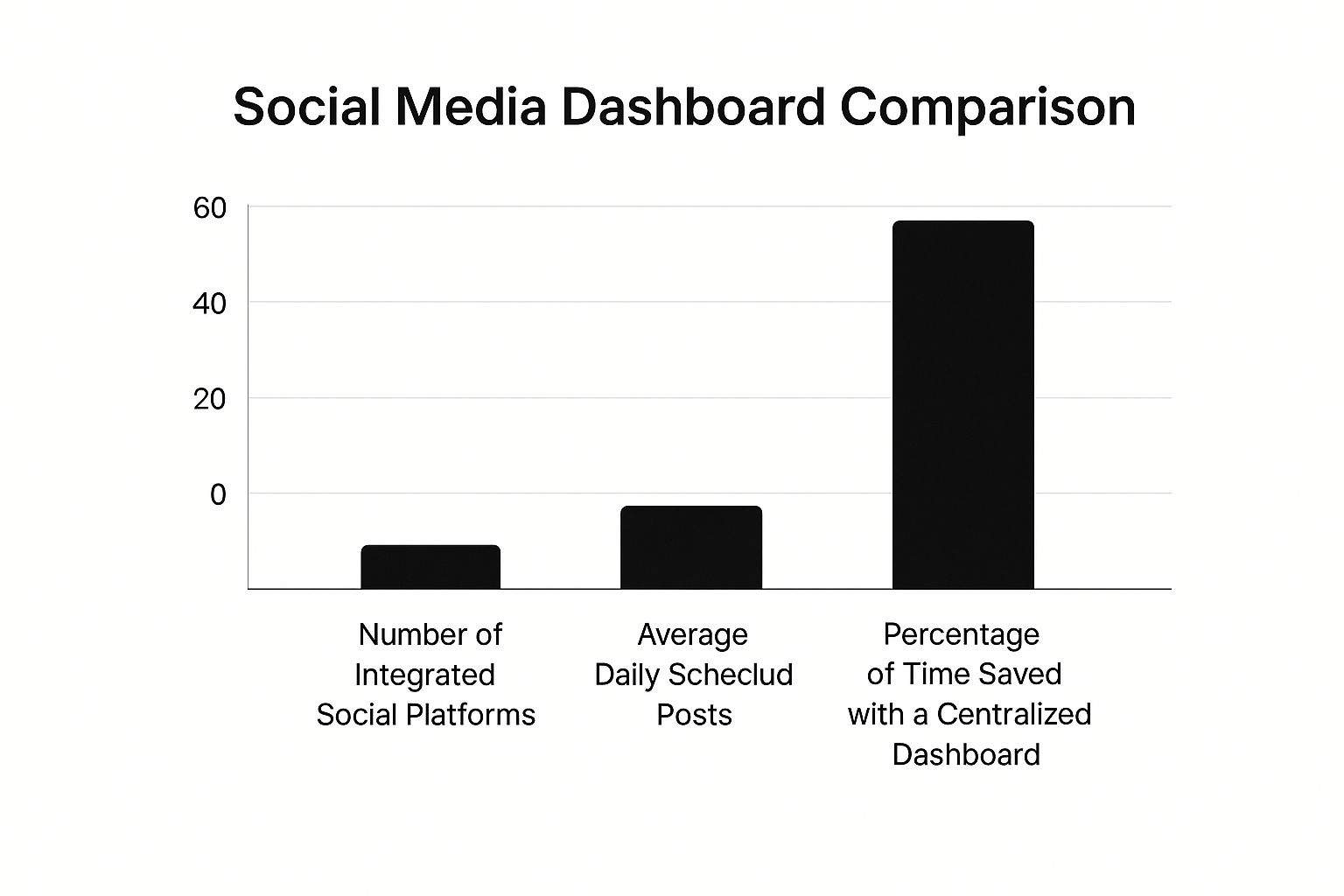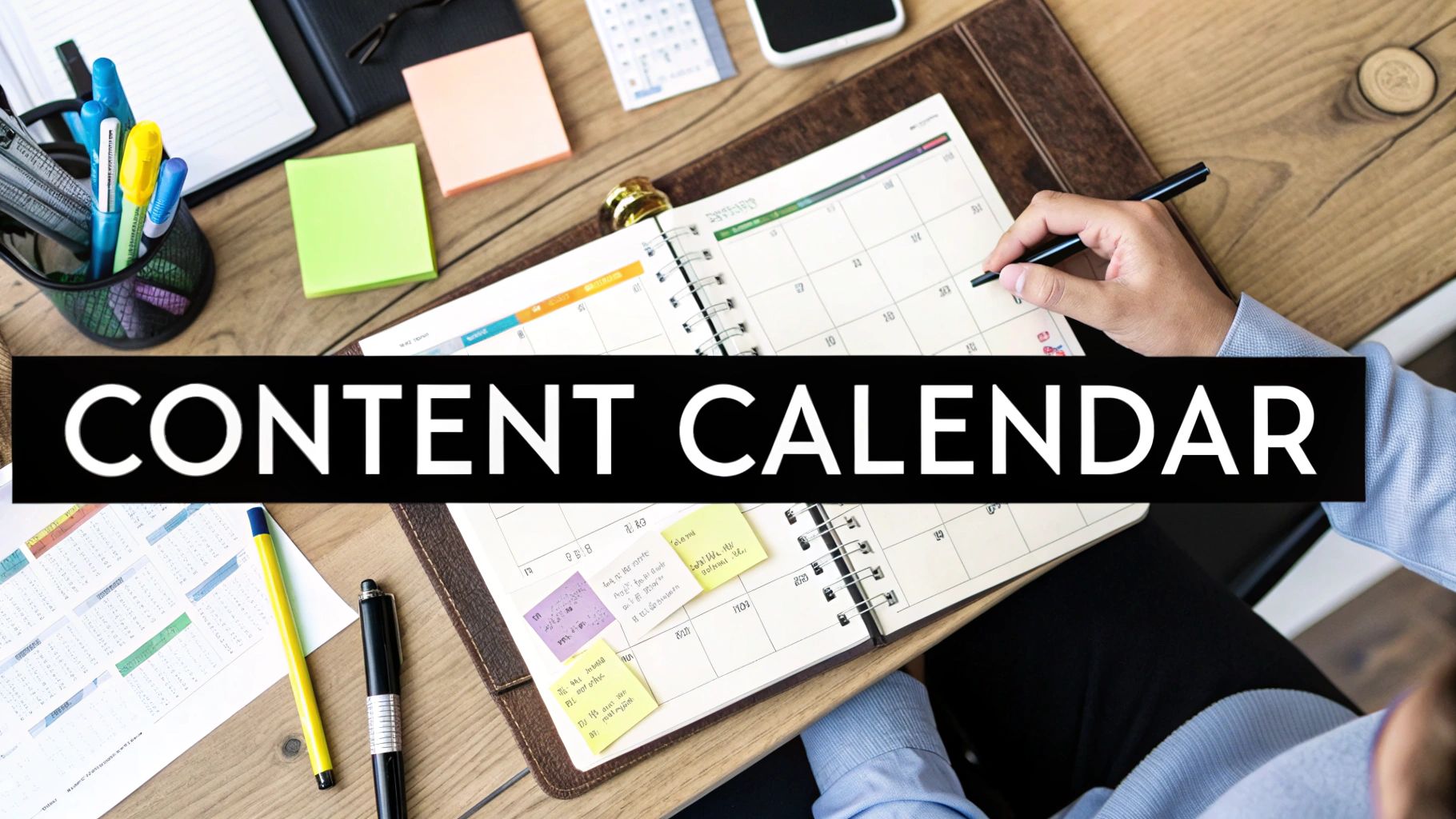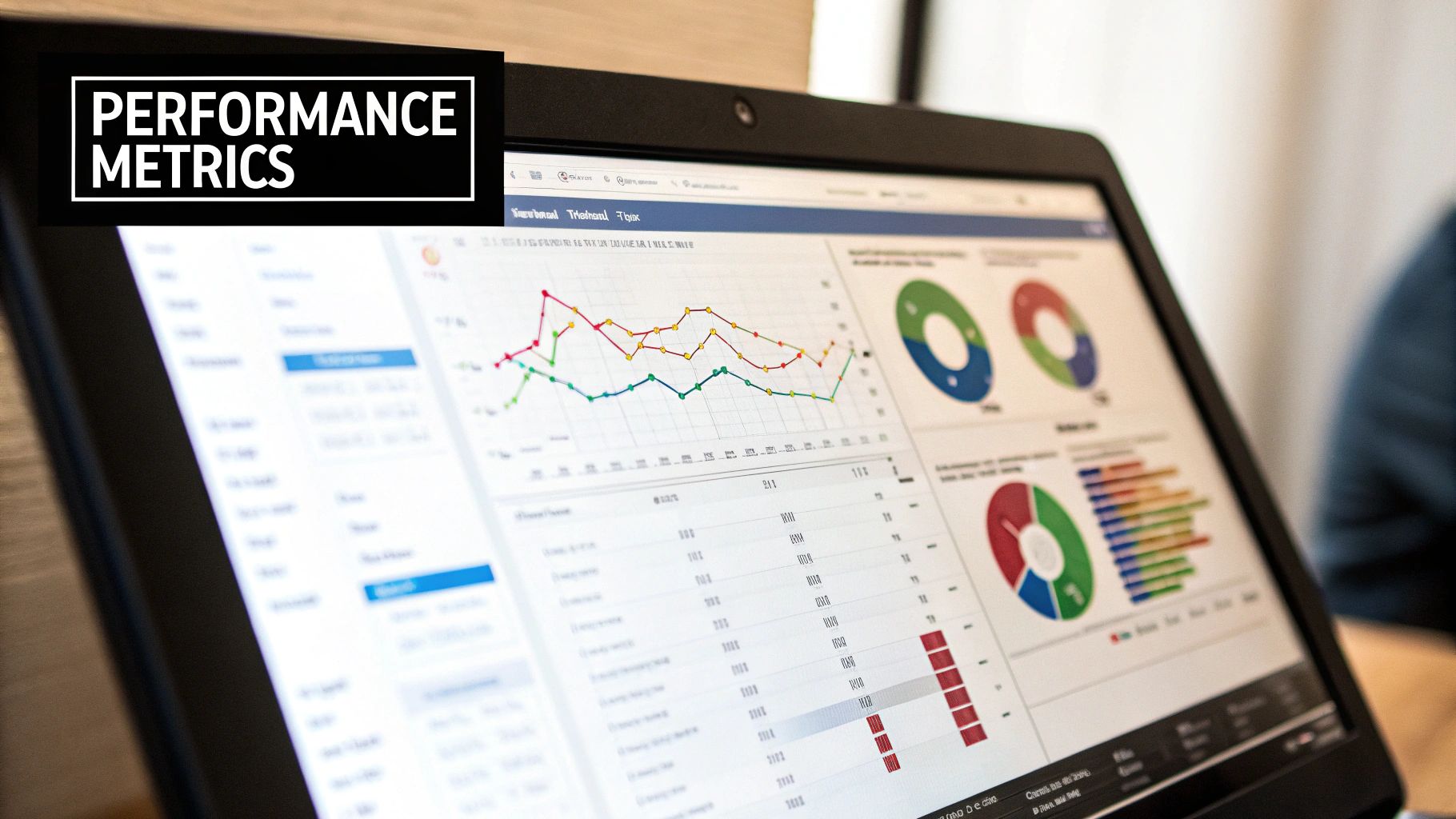If you're juggling multiple social media accounts, you know the grind. Bouncing between platforms, trying to keep your brand's voice consistent, and just keeping up with posting schedules can lead to serious burnout. The secret isn't just working harder—it's moving past manual posting and adopting a single, unified workflow. This is how you turn a chaotic chore into a real strategic advantage.
Why You Can't Afford to Ignore Multi-Platform Management

Let’s get one thing straight: having a social media presence isn't optional anymore. But the real challenge today is that your audience isn't just on one platform. Their attention is fragmented across a half-dozen apps on their phone. They might see your brand in a TikTok video, get curious and check out your Instagram, then head over to LinkedIn for a more professional look.
When you manage each platform in a silo, your brand message gets messy. Your tone might be fun and energetic on one channel but stiff and corporate on another. That kind of inconsistency doesn't just confuse your followers; it erodes trust and leads directly to missed opportunities.
Meeting Your Audience Where They Already Are
Your ideal customers don't live on a single app, so your brand shouldn't either. The path a modern consumer takes is a winding one, crossing multiple digital touchpoints before they ever make a decision. Being active on the right platforms allows you to:
- Reach Different Crowds: The people scrolling through TikTok are a world away from the professionals on LinkedIn. A smart multi-platform strategy lets you tailor your message to connect with entirely different segments of your market.
- Build Brand Recognition: Consistency is key. When people see your brand pop up across different feeds, it builds familiarity and makes you look more credible. Every single impression reinforces your brand in a potential customer's mind.
- Offer Support Everywhere: Customers now expect to reach you wherever it's most convenient for them, whether that's dropping a comment on an Instagram post or sending a quick Facebook message.
Managing multiple social media accounts isn't just for big agencies anymore. It's a fundamental need for any creator or business trying to grow in a world where attention is the most valuable currency.
The data tells the same story. The average person now uses 6.83 different social networks every single month. With over 5.42 billion people on social media globally, trying to manage platforms like Facebook, Instagram, and Threads one by one is just not a sustainable way to operate. If you're curious about the numbers, you can dive into the latest social media statistics to see the trends for yourself.
The Power of a Central Command Center
It's time to reframe how you think about this. Managing multiple accounts isn't a chore; it's a strategic asset. When you use a centralized system powered by a tool like LATE, you're not just saving time. You're building a command center for your entire digital voice.
Suddenly, you have a bird's-eye view of all your content, engagement, and performance data in one place. What was once a series of disjointed, frantic efforts becomes a cohesive and powerful marketing engine.
Choosing Your Social Media Command Center
Picking the right tool to manage your social media accounts is a big decision. It’s not just about finding the one with the longest feature list. You're essentially building a central command center that needs to fit your specific workflow, your budget, and the size of your team. The real goal here is to find a system that doesn't just centralize your work but actually gives you back your most valuable asset: time.
A solo creator’s biggest win might be a simple, clean scheduler that keeps them from burning out. An agency, on the other hand, is going to need heavy-duty collaboration features, multi-step approval flows, and slick, client-ready reports. Before you even think about looking at a pricing page, you need to be brutally honest about your "must-haves."
Defining Your Core Needs
So, what’s the real problem you're trying to fix? Is it the pure chaos of logging in and out of five different apps every morning? Or is it the frustrating lack of a single place to see what’s actually working? Pinpointing your primary pain points is the only way to find a solution that genuinely helps.
A great place to start is to make a list of features you absolutely can't operate without. For most of us, that list usually includes:
- A Unified Inbox: This is a game-changer. It pulls all your DMs, comments, and mentions from every single platform into one feed. No more missed messages or frantically switching between apps.
- Bulk Scheduling: The ability to plan out your content calendar for the week—or even the month—and upload it all in one go is a massive time-saver.
- Collaborative Analytics: Your whole team needs to be looking at the same numbers. A single dashboard that clearly shows what’s performing (and what’s tanking) across all channels is non-negotiable.
This infographic really drives home the impact of switching to a centralized tool.

As you can see, the time you get back from centralizing your dashboard directly fuels your ability to schedule more content on more platforms. It creates a powerful loop of efficiency.
Evaluating Based on Scale and Platforms
The sheer size of the audience you’re trying to reach makes this decision critical. The numbers are staggering: Facebook leads the pack with roughly 3.06 billion monthly active users, followed by YouTube at 2.50 billion, Instagram at around 2 billion, and Twitter (now X) holding strong with 611 million users. If you want to learn more about the raw data, you can dig into these platform population trends.
To effectively coordinate content across these giants, you’ll want to look at established players.
Many teams start by comparing the big names in the space to see what fits their immediate needs. Tools like Hootsuite, Buffer, and Sprout Social are popular for a reason, but they all have different strengths.
Feature Comparison of Top Social Media Management Tools
Here’s a quick breakdown to help you see how some of the most popular tools stack up against each other. This isn't exhaustive, but it covers the core features most teams look for when getting started.
| Feature | Hootsuite | Buffer | Sprout Social |
|---|---|---|---|
| Unified Inbox | Yes, with advanced filtering | Yes, for comments and mentions | Yes, with CRM-like features |
| Bulk Scheduling | Yes, via CSV upload | Yes, with a straightforward queue | Yes, with calendar and asset library |
| Analytics & Reporting | Comprehensive, customizable reports | Clean, easy-to-understand metrics | Deep analytics with competitor analysis |
| Team Collaboration | Yes, with approval workflows | Yes, with user roles (on paid plans) | Yes, extensive team and task management |
| Best For | Agencies, large teams | Solopreneurs, small businesses | Mid-to-large businesses, enterprises |
Ultimately, your choice depends on which platforms you prioritize and the true scale of your operation.
I’ve seen it happen a dozen times: a team pays for a premium tool with advanced reporting for ten platforms, but they only have the bandwidth to actively manage three. Be realistic about your resources.
For developer-led teams or agencies who need maximum flexibility, an API-first solution like LATE offers a totally different kind of command center. Instead of being locked into a pre-built dashboard, you can build your own custom workflows. This means you can integrate social scheduling directly into the software you already use, giving you ultimate control over your entire content pipeline.
At the end of the day, your command center should feel less like another piece of software you have to manage and more like a trusted partner. It should simplify your process, offer clear insights, and empower you to build a cohesive brand voice across every channel that matters to your audience.
Building a Cohesive Content Workflow
 To really get a handle on managing multiple social media accounts, you need more than a scheduling tool—you need a system you can repeat. Without a solid workflow, you're always playing defense, waking up and scrambling to answer, "What am I supposed to post today?" This is where the real work of content strategy begins.
To really get a handle on managing multiple social media accounts, you need more than a scheduling tool—you need a system you can repeat. Without a solid workflow, you're always playing defense, waking up and scrambling to answer, "What am I supposed to post today?" This is where the real work of content strategy begins.
A well-oiled workflow stops your social media from being a chaotic mess of random posts and turns it into a unified story for your brand. It gives you structure, keeps things consistent, and, most importantly, saves you from the daily panic of staring at a blank content calendar. The aim is to build a predictable engine that consistently churns out great content for every platform you're on.
Adopting the Pillar Content Model
One of the most effective strategies I’ve seen for creating a sustainable content flow is the pillar content model. This approach completely flips the script on how you create content. Instead of trying to dream up dozens of small, disconnected ideas, you start by creating one big, valuable piece of content.
This "pillar" can be any significant piece of work:
- A long-form blog post or an in-depth guide
- A detailed YouTube video or a live webinar
- An original research report or a customer case study
- A podcast episode or an expert interview
Once you have this core asset, the fun part starts. You strategically slice it up into smaller, platform-specific "micro-content." This isn't just a copy-paste job; it's smart repurposing.
Key Takeaway: A single 2,000-word blog post can easily be broken down into a full week's worth of content. Think quote graphics for Instagram, a discussion thread for LinkedIn, a quick tips video for TikTok, and a few poll questions for X.
This model is a game-changer for efficiency. It ensures your main message gets hammered home across all your channels, but in a way that’s tailored to each platform’s audience and format. You end up working smarter, not harder, creating a web of interconnected content that all leads back to your main asset.
Constructing a Purpose-Driven Content Calendar
Your content calendar is the blueprint for your entire workflow. A truly effective calendar goes way beyond just scheduling post times; it’s about balancing different types of content to keep your audience hooked and guide them toward your business goals. A simple but powerful way to do this is by sorting your posts into different themes or buckets.
For instance, a healthy content mix might look something like this:
- Educational Content (40%): Posts that teach, inform, and deliver genuine value. This is your "how-to" content, industry insights, and tips that actually solve your audience's problems.
- Community-Building Content (30%): Posts made to spark conversation and get people talking. We're talking questions, polls, featuring user-generated content, and sharing behind-the-scenes glimpses.
- Promotional Content (20%): The direct asks. These are posts about your product, services, or special offers. They’re absolutely necessary, but you want to use them just enough to be effective without annoying your audience.
- Curated Content (10%): Sharing great articles, news, or posts from other respected voices in your field. This positions you as a helpful, in-the-know resource.
When you map these categories onto your calendar, you stop just posting and start posting with a clear purpose. If you’re looking to put this into practice, our detailed social media workflow template gives you a framework that's ready to go. By building out this kind of systematic approach, you create a powerful, cohesive presence that drives real results.
Mastering Content Automation and Scheduling
Once you have your workflow mapped out, you can get to the really good stuff: automation. This is where you graduate from simply organizing your content to making it work for you. We're talking about transforming your multi-platform social media management from a daily grind into a "set it and forget it" system.
The idea here is to get your time and mental space back. Instead of constantly stressing about what to post next, you can focus on bigger-picture strategy and actually talking with your audience. This leap is possible when you start using scheduling tactics that go well beyond the basics.
Beyond Basic Post Scheduling
If you want to unlock serious automation power, you need to use features built for efficiency at scale. This is the secret sauce for social media managers who juggle tons of profiles without losing their minds. You can confidently prep a week's—or even a month's—worth of content in one sitting, knowing your accounts will stay active without you lifting a finger every day.
A couple of the most powerful strategies I've used are:
- Evergreen Content Queues: Every brand has timeless content—great blog posts, helpful tips, or popular old updates. Build a library of this stuff, and a tool can automatically pull from it to fill any gaps in your content calendar. Your profiles will never go dark.
- Bulk Uploading with a CSV: When you're launching a big campaign or just have a burst of inspiration, mapping it all out in a spreadsheet is way faster. You can then upload a single CSV file to schedule dozens, sometimes hundreds, of posts across all your platforms at once.
This approach is a game-changer for agencies or anyone managing client accounts. Just imagine onboarding a new client and getting their first month of content scheduled in a single afternoon. That’s what bulk scheduling does for you.
These methods completely change how you interact with your content calendar. You're no longer just a worker bee; you're the architect of the whole system. For a deeper look into these techniques, check out our complete guide on how to schedule social media posts.
Harnessing AI for Smarter Publishing
Lately, artificial intelligence has become a massive help in content management. And it's no wonder. People spend over 14 billion hours on social media every single day. To stand out in that ocean of content, you need an edge, and AI provides it. In fact, 90% of businesses using generative AI report saving a significant amount of time, and 73% see better engagement. You can read more about these social media consumption and AI trends to see just how big the impact is.
AI tools built into platforms like LATE can do some heavy lifting for you:
- Generate Post Variations: Give the AI a core idea, and it can spit out multiple versions, each tweaked for a different platform. Think a professional tone for LinkedIn, a quick question for X, and a catchy hook for your Instagram caption.
- Pinpoint Optimal Post Times: Stop guessing when to post. Let an AI tool chew on your performance data. It will tell you exactly when your audience is most active and engaged on each specific platform, then recommend the perfect times to schedule your content.
By blending smart automation with AI-powered insights, you create a system that's not just efficient but also resilient. It gives you the confidence and foresight of a seasoned strategist, freeing you up to focus on the one thing that truly matters: building real relationships with your audience.
Engaging Audiences and Analyzing Performance

Getting your content scheduled is a huge win, but let’s be real—it’s only half the story. The real magic happens after you post. This is where you shift from just broadcasting content to actually building a community. Real, meaningful engagement is what turns followers into loyal fans.
If you're serious about managing multiple accounts, you can't be jumping between five different apps to check DMs and reply to comments. It's a recipe for chaos, missed messages, and slow replies that can tarnish your brand's image. A unified social inbox changes the game, pulling all your interactions—comments, mentions, and DMs—from every platform into one clean, manageable feed.
One Inbox to Rule Them All
Picture it: all your audience interactions, neatly organized in a single dashboard. No more frantic tab-switching or logging in and out. This centralized setup means you can answer people faster and more thoughtfully, making sure no one gets left on read.
This isn't just a matter of convenience; it’s about delivering great customer service. When people see you’re responsive and helpful everywhere, it builds trust. Think about it—a customer might see your TikTok, get curious, and slide into your Instagram DMs with a question. A unified inbox ensures that query gets the same prompt attention as a comment on a LinkedIn post.
The most rewarding part of handling multiple accounts is seeing direct results from your interactions. A single, timely response can turn a curious follower into a loyal customer, and a unified inbox makes that level of service possible at scale.
This direct line to your audience is also your best source of feedback. You get a raw, unfiltered view of what content is hitting the mark, what questions people are asking, and what problems they need solved. That kind of insight is pure gold for refining your content strategy.
Tracking Analytics That Actually Matter
Once you've got your engagement humming along, the next step is to figure out what's actually working. It's easy to get bogged down in vanity metrics like follower counts, but true growth comes from analyzing data tied directly to your goals. You need to focus on metrics that tell a clear story and prove your strategy is delivering.
A consolidated analytics dashboard is a must. Instead of painstakingly pulling separate reports from each platform, a tool like LATE gives you a single, holistic view of your performance. Finally, you can compare apples to apples and see the big picture.
You should be keeping a close eye on a few key performance indicators (KPIs):
- Engagement Rate: This shows how much your audience is actually interacting with your content. It’s a fantastic indicator of content quality and relevance.
- Reach and Impressions: This tells you how many unique people see your posts and how many times your content was displayed. It's the top of your funnel.
- Click-Through Rate (CTR): For posts with links, this measures how many people are taking the action you want. It's a direct measure of how compelling your call-to-action is.
- Conversions: The bottom line. This tracks how many users completed a desired action, like signing up for a newsletter or making a purchase, after clicking a link from your social post.
Focusing on these numbers helps you move beyond guesswork. If you really want to get into the weeds, our guide on essential social media performance metrics breaks down exactly what you should be tracking. This data-driven approach is what allows you to refine your strategy, prove your ROI, and make smarter decisions that will actually grow your presence.
Tackling Common Questions About Managing Social Accounts
Once you start managing social media for more than one brand or across multiple platforms, the questions start piling up. It’s normal. Even those of us who’ve been in the trenches for years run into new challenges. So, let’s walk through some of the most common hurdles people face and how to clear them.
Do I Really Need Different Content for Each Platform?
One of the first questions everyone asks is whether they can just post the same thing everywhere. The short answer? Please don't. While it’s smart to repurpose a core message, a lazy copy-paste across platforms often does more harm than good.
Think about it—each network has its own vibe and audience expectations. That in-depth, professional post that gets great engagement on LinkedIn will likely get scrolled past on Instagram.
The goal is to adapt, not just duplicate. You're telling the same core story, but you're tailoring the delivery. If you're launching a new product, that might look like:
- A formal announcement on LinkedIn.
- A behind-the-scenes video on TikTok.
- A polished, high-resolution photo carousel on Instagram.
How Should I Handle Negative Feedback Across All My Accounts?
Negative comments are going to happen. It's just part of being online. How you deal with them is what separates the pros from the amateurs. Ignoring them or getting defensive is the fastest way to make a bad situation worse. This is where having a unified inbox becomes a lifesaver, so you never miss a comment, good or bad.
Here’s a simple, effective game plan for responding:
- Acknowledge the complaint quickly and publicly. Don't make excuses.
- Offer a sincere apology for their bad experience.
- Move the conversation offline. A simple "I've sent you a DM to get the details and make this right" works wonders.
This strategy shows your entire audience that you're responsive and genuinely care about customer satisfaction. It calms the immediate situation and takes the nitty-gritty of resolving it out of the public eye.
People always ask for the "magic number" of platforms to be on. There isn't one. It's far better to be truly excellent and engaged on the two or three channels where your audience actually hangs out than to be stretched thin and mediocre across six.
Can You Over-Automate Your Social Media?
Absolutely. There's a fine line between efficiency and sounding like a robot. Automation is an incredible tool, but it should handle the grunt work, not the human connection.
Use automation for scheduling posts and distributing content. But never automate your engagement.
The real magic happens in the replies, the DMs, and the genuine conversations. That’s what builds a loyal community. Let a tool like LATE manage the logistics of getting your content out there. That frees you up to do what really matters: connect with the people on the other side of the screen.
Ready to stop juggling tabs and start building a unified, automated workflow? With LATE, you can manage all your social accounts from a single API, saving countless hours and ensuring your brand voice is consistent everywhere. Get your API key and start building for free.